KCSE Past Papers 2017 Woodwork Paper 1
Click Here - Free KCSE Past Papers » KCSE Past Papers 2017 Woodwork Paper Paper 1 » Free Downloads » KCSE Papers & Marking Schemes
KCSE Past Papers 2017 Woodwork Paper Paper 1
2017 Woodwork - Paper 1
Section A (40 marks)
Answer all the questions in this section in the spaces provided.
1 (a) State two advantages of water stains. (2 marks)
(b) State two disadvantages of spirit stains. (2 marks)
2 Name three types of saws in each of the following categories: (3 marks)
(a) Hand saws.
(b) Curve cutting saws.
3 (a) Explain the cause of each of the following timber defects: (2 marks)
(i) Heart rot
(ii) Knots
(b) List four types of glue used for veneering. (2 marks)
4 State four safety rules to observe when using a power drill to drill a hole in a piece of wood. (4 marks)
5 With the aid of a sketch, explain how the trueness of a try square is tested using a board and a straight edge. (4 marks)
6 With the aid of a labelled sketch, explain the ‘toenailing’ method of driving nails. (4 marks)
7 Figure 1 shows the blade of a Jack plane fitted in two different ways.
Figure 1
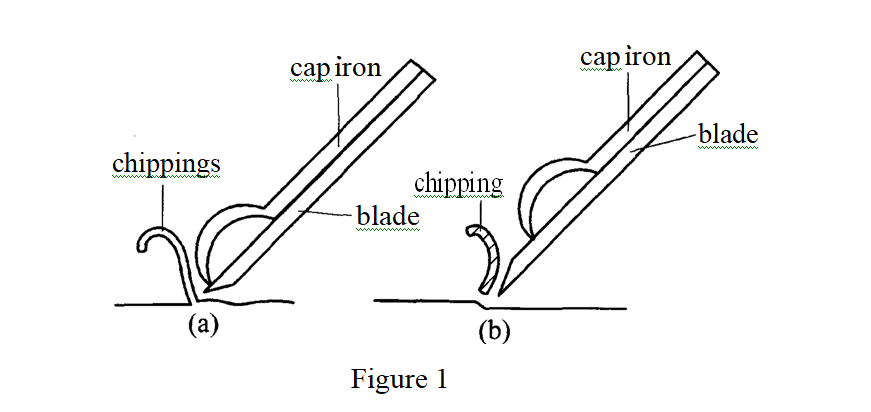
8 (a) State four factors which may cause closure of a business. (2 marks)
(b) Sketch the following patterns of matching veneers. (2 marks)
(i) Diamond
(ii) Slip
9 With the aid of labelled sketches, illustrate two methods used to prevent a piece of wood from splitting at the end when drilling a hole. (4 marks)
10 Figure 2 shows a shaped block drawn in isometric projection.
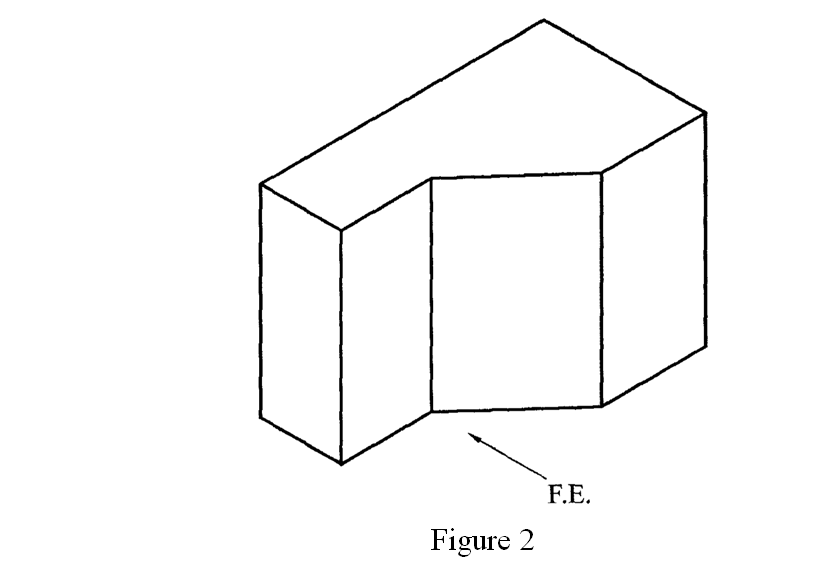
Section B (60 marks)
Answer question 11 on the A3 pal er and any other three questions from this section in the spaces provided.
Candidates are advised not to spend more than 25 minutes on question 11.
11 Figure 3 shows two views of a truncated square pyramid drawn in first angle projection.
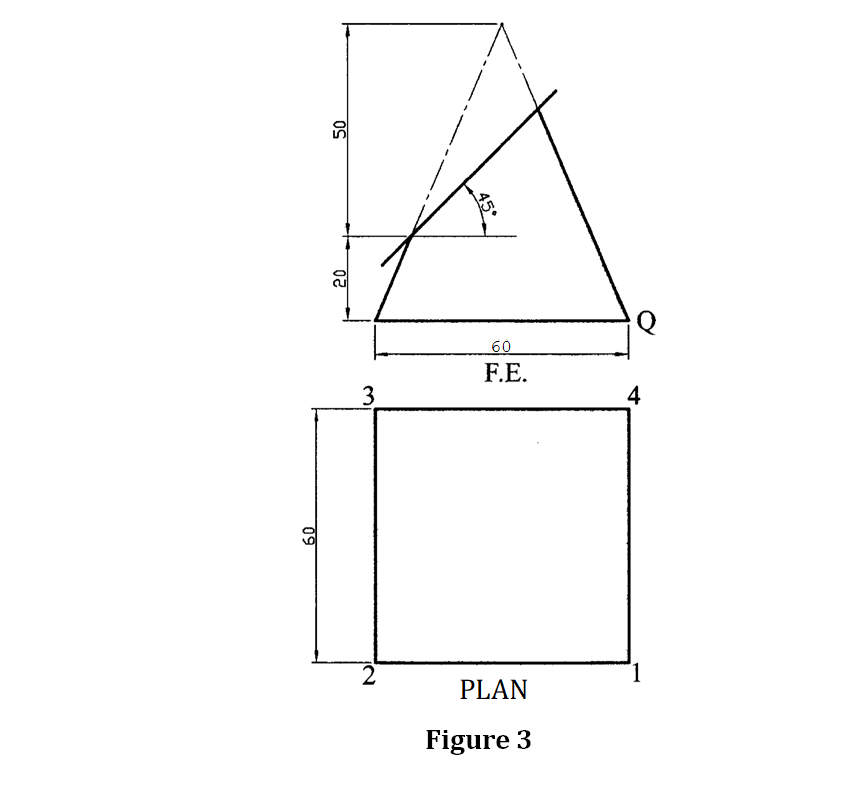
(a) Complete plan. (15 marks)
(b) True shape of the cut face.
(c) Development of the pyramid when opened along P-Q.
12 (a) Explain the following methods of laying veneers: (4 marks)
(i) Hammer veneering
(ii) Caul and press veneering
(b) Outline the procedure of shooting end grains of a piece of wood 50 X 100 mm using a bench plane and bench vice only. (5 marks)
(c) With the aid of sketches, describe the following timber defects:
(i) Twist
(ii) Bow
13 (a) Figure 4 shows boring tools labelled X and Y. (6 marks)
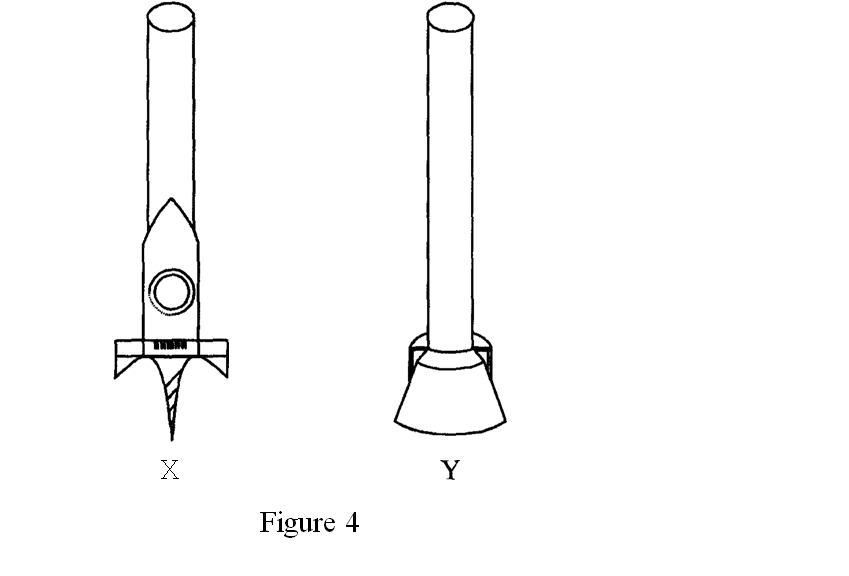
(ii) State one function of each of the tools in 13 (a) (i) above. (3 marks)
(b) Outline the procedure of sharpening the cutting blade of a Jack plane using an oil stone. (6 marks)
(c) Figure 5 shows a part of a bridle mitre joint.
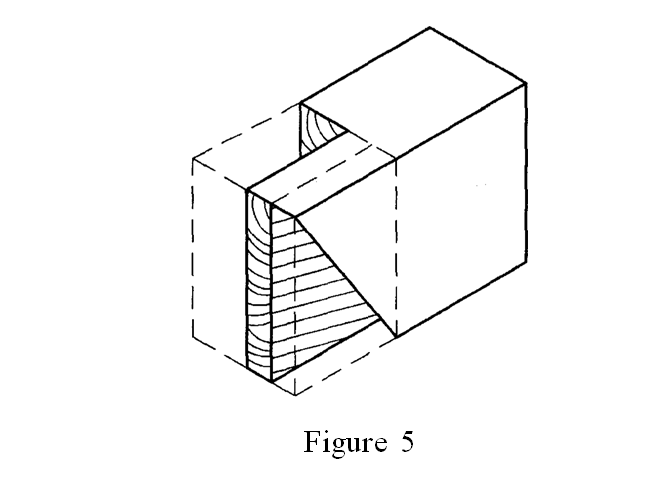
14 (a) Explain the difference between the following terms, giving two examples in each case: (4 marks)
(i) Public sector
(ii) Private sector
(b) Figure 6 shows a device used in a wood workshop.

(ii) Name the parts labelled A and B.
(iii) State the function of the device.
(iv) State two safety precautions to observe when using the device.
(c) State six safety precautions to observe when using a surface planer.
15 (a) Using pictorial sketches, show the difference between square and secret haunch tenon.
(b) Figure 7 shows three views of a kitchen stool.
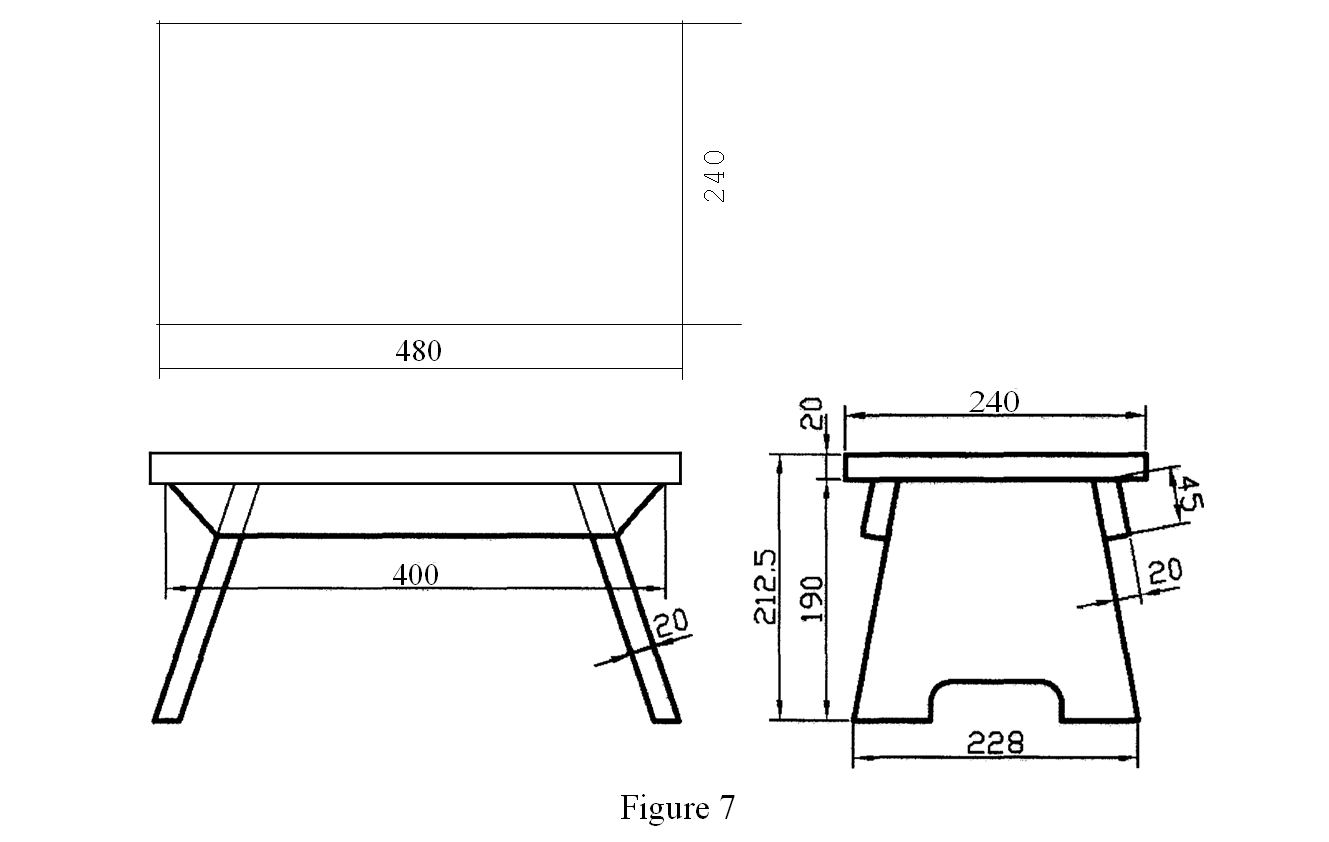
Timber 250 X 25 mm — Ksh 100 @ 300 mm
50 X 50 mm — Ksh 60 @ 300 mm
Nails 38 mm long — Ksh 120 @ 1 kg
Sandpaper Ksh 20 @ sheet
Allow 35% profit and overheads.
NB/minimum timber lenth sold — 150 mm
(i) Prepare a cutting list for the materials required.
(ii) Calculate the cost of making the stool. (12 marks)
Marking Scheme
2017 Woodwork - Paper 1
1. (a) Advantages of water stain
2 marks
(b) Disadvantages of spirit stains
2. (a) Hand saws
- Tennon saws, dovetail saws, backsaw, rip saw, cross-cut saw, panel saw. Any 3
(b) Curve cutting saw
3. (a) (i) Heart rot
Decay caused by fungi near the heart of the living tree, it includes the pith and some of the true wood.
(ii) Knots
Occurs when a branch or a limb is cut through during the growth of the tree.
(b) Types of glue used for veneering;
- Animal glue - Synthetic resin
Casein glue - Contact or/impact adhesive
Safety when using power drill:

Then turn the square over. Any inaccuracy will show as a divergence of the line and the blade.
6.

It is advisable to always stagger the nails and angle to avoid nails hitting one another.
7. The cap iron is fitted close to the cutting edge and the cutting iron is fitted with the beveled edge against the stock.
This correct positioning of the cutting iron allows the shaving to immediately bend and break resulting in clean cuts.
The cap iron is fitted on the beveled side of the cutting iron.
The shavings elongate and rip out of the surface of the board as opposed to being bent and broken resulting in rough cuts.
( a) Factors that may cause closure of a business:
b Patterns of matching veneers.

(b) Using a piece of scrap stock to bore directly through the work.


A method of laying veneers when a veneer hammer is used to press the veneers into close contact with the core and squeeze out excess glue and air bubbles.
(ii) Caul and press veneering
The veneers are pressed into close contact with the glued core by means of cauls with bearers and cramps or mechanical press.
(b) Procedure of shooting end grain
Mark the required true end.
Firmly squeeze the stock against the chosen tail with one hand about 1mm projecting over the bed.
(c) (i) Twist
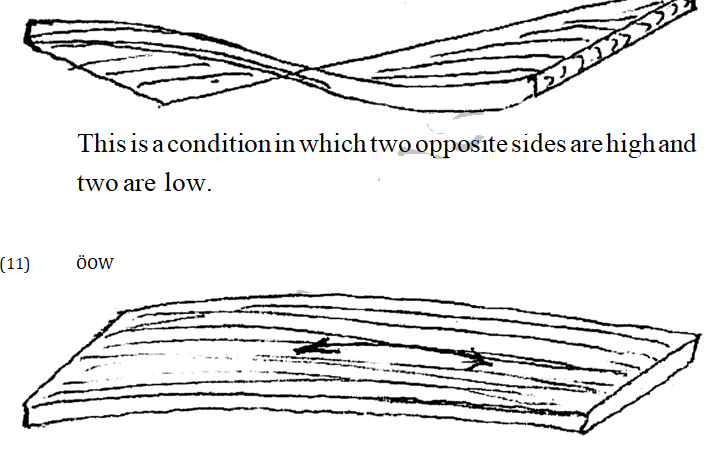
13. (a) (i) names or bits
x — Expansive bit
y — Forstner bit
(ii) Expansive bit
Used for boring holes of varying diameters in softwood.(1)
Forstner bit
Drills an accurate flat bottomed hole I.
(a). procedure of sharpening the cutting tilade or a jack plane using an oilstone
Procedure of marking and cutting
1 — Measure and mark the length of tennon using a pencil and try square.
2 — Divide the width of the piece into 3 equal parts and draw the lines to the length mark.
3 — Mark one face of the tennon using a try square.
4 — Turn to the other face and mark the mitre with the bevel square.
5 — Cut the face marked square and remove the waste.
6 — Cut the mitre and remove the waste.
(i) ruolic Sector:
These are government owned organizations which provide services to the public.
Examples: - Government ministries
(ii) Private Sector
These are organizations that are privately owned and not part of government.
Examples: - Private corporations
- Partnerships
- Sole business e.t.c
(b) (i) Name of device
Cutting gauge,cutting board/mitre template
(ii) Name of parts
A — Stock
B — Adjustable stopper
(iii) Used when cutting many pieces of equal length.
(iV) Safety precautions to observe:
(i) Ensure that the device is held firmly on the working bench.
(ii) Ensure that cutting is along the slot.
(iii) Hold the stock firmly to avoid vibration.
(c) Safety precaution to be observed while using a surface planes.
Ensure no loose parts before you switch on the machine.
Remove all loose knots from the stock before surfacing.
15. (a)


Kenya Scholarships for Undergraduate Students » Kenya Scholarships for Postgraduate Students » Undergraduate Scholarships for Kenyan Students » Kenya Undergraduate Scholarships » Full Undergraduate Scholarships for Kenyans » Kenya Postgraduate Scholarships » Scholarships & Grants » Undergraduate Scholarships » Universities in Kenya » Kenya Universities and Colleges Central Placement Service (KUCCPS) » Colleges in Kenya » KASNEB Registration & Results » Secondary Schools Scholarships in Kenya » Undergraduate & Graduate Scholarships for Kenyans
Scholarships for African Students » Undergraduate Scholarships » African Women Scholarships & Grants » Developing Countries Scholarships » Erasmus Mundus Scholarships for Developing Countries » Fellowship Programs » Funding Grants for NGOs » Government Scholarships » LLM Scholarships » MBA Scholarships » PhD and Masters by Research Scholarships » Public Health Scholarships - MPH Scholarships » Refugees Scholarships » Research Grants » Scholarships and Grants
Scholarships in Australia » Scholarships in Belgium » Scholarships in Canada » Scholarships in Germany » Scholarships in Italy » Scholarships in Japan » Scholarships in Korea » Scholarships in Netherlands » Scholarships in UK » Scholarships in USA
Scholarship 2025/26
Current Scholarships 2025/2026 - Fully FundedFull Undergraduate Scholarships 2025 - 2026
Fully Funded Masters Scholarships 2025 - 26
PhD Scholarships for International Students - Fully Funded!
Funding Opportunities for Journalists 2025/2026
Funding for Entrepreneurs 2025/2026
***
